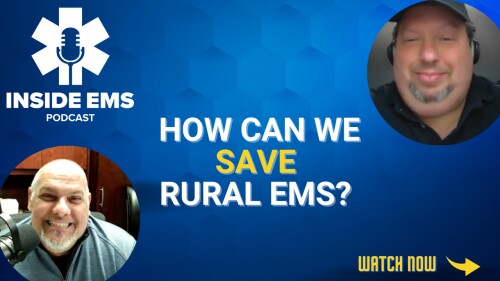The lament is nationwide: “Volunteerism is dying.” More accurately, volunteerism is changing, largely due to increased demands of the job.
In the beginning of EMS in the U.S., the Red Cross Advanced First Aid class took about 60 hours to complete [1]. At the time, a rural ambulance service might have averaged a call or two per week. Currently, an initial EMT class lasts over 150 hours, and those same rural ambulances now average a call or two per day, even in areas where population demographics and service areas have remained largely unchanged [2,3]. Additionally, increased regulation of patient care reports has added significantly to the time commitment for each call [4].
The increasing demands of emergency work have led many workplaces to go to an all-paid staffing model, but the door should remain open to volunteers, resulting in a hybrid paid-volunteer workforce. A robust field of volunteer emergency responders offers the following benefits: [5].
- Increased experienced responders in the community. While it takes volunteers longer to gain similar baseline experience compared to full-timers, it’s important to think about bigger-picture benefits. When off-duty, those volunteers are out in the community. A huge piece of a positive outcome is dumb luck, especially in rural areas: someone happens to be close by, responds quickly, and provides some basic, critical care.
- Supplemental staffing. Some people love EMS and want to serve their community, but they have other commitments that preclude full employment in EMS. It would be unfair to expect a school principal to quit and work full-time in EMS, but if they can fit in some volunteer emergency work, this benefits many people. Allowing a mix of volunteers and paid employees can also be the most effective method for filling a schedule.
- Surge capacity. Further, in a disaster like a school bus crash, an all-paid ambulance service might have a handful of off-duty responders to call on. Having volunteers on the roster can mean there are dozens of additional off-duty responders. This surge capacity is an oft-forgotten but critical benefit to the overall system.
- Hands-on training. Laypersons take CPR and first aid classes in all kinds of workplaces, but if they never use their skills, they may struggle in emergencies. CPR skills degrade within 3-6 months of a class [6]. People who respond to even a handful of real emergencies per year are far better prepared to act appropriately in critical moments.
- Diverse skill sets. Hybrid workplaces benefit from volunteers in more than just savings from “free” labor. Volunteers may include professional builders, mechanics, lawyers, finance experts, teachers, farmers, and even higher trained medical personnel like nurses or doctors. All of these individuals bring their aptitudes not just to the organization, but to each other, in turn increasing everyone else’s knowledge in these various fields.
- The extra mile. People volunteer because they care about their community and want to give back. This altruistic motivation may lead a volunteer responder to do a little bit extra for patients. A paid responder taking double digit calls per week may have less emotional energy to go the extra mile on each call for service. In this way, volunteers might provide more compassion beyond the technical aspects of emergency service.
- Improve paramedic safety. Paid organizations often require that new employees have experience. Volunteering is a great way people can gain experience in emergency service. Volunteerism allows people with no prior experience to join an organization and learn under the watchful eye of veteran responders. This puts extra hands on many calls, and extra hands can help with physical tasks like lifting, which can prevent injuries. Volunteer organizations must inherently be teaching and learning environments, and this constant teaching and learning process sharpens everyone’s skills and increases attention to detail, further increasing safety.
Remove barriers to volunteering
A word of caution: one should not presume that a person would only volunteer because they have no experience. If a volunteer applicant otherwise qualifies for a paid position, the organization should respect this expertise and onboard them accordingly. Unless there is a safety-based or other compelling reason for doing so, the hierarchy within a hybrid workplace should not discriminate based on a responder’s paycheck or lack thereof.
When other skilled professionals volunteer their time, we do not automatically expect them to be less skilled. When doctors and lawyers work for free, it’s not called “volunteering,” it’s called “pro bono,” from the Latin phrase, pro bono publico, meaning for the public good.
Nearly all services for the public good should have avenues to welcome volunteers. A hybrid paid/volunteer model of emergency service captures the altruism and flexibility of volunteerism, improves staffing and benefits from the unique strengths that all members contribute to the team. The quality of patient care can remain high, the system and the public can benefit from an increased number of off-duty responders in society, and the collaboration between personnel can continue to build and strengthen community. Paid and volunteer emergency responders can and should work side-by-side for the good of their communities.
References
- Personal Communication with Robert Gleason, former director of Enosburgh Ambulance Service, Enosburg Falls, VT. December, 2021.
- Shah M. . March 2006; 96(3): 414–423. Accessed July 26, 2023.
- Federow D. .The Municipal, April 2022. Access July 26, 2023.
- , section 5.4.3.11. Accessed July 26, 2023. , Page 2, accessed February 23, 2023.
- Magee N. Why volunteers are critical to the future of EMS. SA���ʴ�ý. 2015. Accessed July 26, 2023.
- Panchal AR, Norton G, Gibbons E, Buehler J, Kurz MC. Low dose high frequency, case based psychomotor CPR training improves compression fraction for patients with in-hospital cardiac arrest. Resuscitation, October 2019, pp 26-31. DOI:













